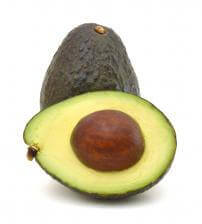What’s the Difference Between California and Florida Avocados?
One is higher in fat; the other is (a lot) higher in calories. Find out which is which.
Botanically speaking, avocadoes are a fruit but they are quite unlike most of the fruits we eat. They are very low in sugar and very high in fat. In fact, in the world of nutrition, we don’t count an avocado as a serving of fruit but as a couple of servings of fat. That doesn’t mean avocados are bad for you; quite the contrary.
 Is the Fat in Avocado Bad for You?
Is the Fat in Avocado Bad for You?
Most of the fat in avocado is monounsaturated, the same type of heart-healthy fat found in olive oil. People whose diets are high in monounsaturated fats have lower risk of heart disease and also tend to be slimmer. Nonetheless, if you’re watching your calories, you want to be aware that avocados pack a lot of calories into a relatively small space.
What’s the Difference Between California and Florida Avocados?
Just how quickly those calories add up depends on what type of avocado you have. Here in the U.S., the two main varieties of avocado are usually referred to as California and Florida avocados. The California avocados (also known as Hass avocados) are the ones with the dark, pebbly skins. The ones with the smooth green rinds are Florida avocados.
How Many Calories Are in an Avocado?
One obvious difference is that Florida avocados are larger than the California variety and so they are quite a bit higher in calories. An average-sized Florida avocado has about 300 calories versus 200 calories for a typical California avocado.
A not-so-obvious difference is that California avocados have a higher fat percentage, which makes them higher in calories if you’re measuring by weight. An ounce of Florida avocado—which is a piece about the size of a golf ball—has about 33 calories, whereas the richer California variety packs about 50-calories per ounce (or golf ball).
This can all get very confusing when you’re trying to look up nutrition information for avocado. In order to get accurate information about fat and calories, you need to be sure that the source is referencing the same type of avocado as you’re eating.
What’s a “Lite” Avocado?
Just to make things a little bit more confusing, you may have seen something labeled a “lite” avocado at the store. This isn’t really anything new. It’s just a new marketing spin that some clever Florida avocado growers came up with. Seeing as Florida varieties are lower in fat, they thought they’d play up that advantage by rebranding Florida avocados as “lite” avocados. But buyer beware: Ounce for ounce, Florida avocados are lower in calories, but you have to remember that they’re also twice as big. If you’re going to eat the whole thing, you’d actually be far better off eating a California avocado.
Which Kind of Avocado is Better?
In terms of flavor and texture, California avocados are richer, creamier, and more avocado-y. They tend to make better guacamole, for example. The one time when I prefer the Florida variety is in grapefruit and avocado salad, which is, not surprisingly, a classic Florida recipe. In this dish, I think the Florida avocados work better because they hold their shape much better and don’t get slimy.
Why Are Avocados Good for You?
In addition to being rich in monounsaturated fats, avocados are also a good source of vitamins C, E, K, folate, and fiber. Not only are they nutritious themselves, but they make other foods more nutritious as well. As I explained in a previous article, adding avocado to salads can vastly increase your absorption of nutrients from the vegetables in your salad. Nice trick, huh?
Related Content: Get More Nutrition From Your Vegetables
More Good Ways to Enjoy Avocados
Guacamole, which is basically mashed avocado, makes a terrific dip for raw veggies. To lighten it up and add extra nutrients, you can add chopped tomatoes or tomatillas or even stir in some prepared salsa. Not only does this make the guacamole more nutritious and not quite as calorie-dense, but the avocado enhances your absorption of the carotenoids from the tomatoes or salsa you add to it or from the raw veggies you dip in it.
(If you already have my new book, look for my recipe for Tomatilla Guacamole on page 207. If you don’t already have it, what are you waiting for?)
Try using a little mashed avocado instead of mayonnaise on a sandwich or even as the basis for a creamy salad dressing.
Related Video content: How to Make the Perfect Salad Dressing
How to Ripen and Store Avocados
Avocados are usually hard when you buy them and you want to let them ripen before you cut them open. (Once cut, they will not get any riper.) They taste best when they’re allowed to sit at room temperature until they are slightly soft, but not mushy. Once they’re ripe, they get overripe quickly, so eat them up as quickly as you can. You can hold a ripe avocado for a few days by putting in the fridge until you’re ready to use it.
If you need to store half an avocado, rub the cut surface with lemon juice or olive oil and then wrap with plastic wrap, making sure the wrap is in contact with the surface, and store in the fridge.
Ripe avocados are also great for your skin and hair! Check out these 5 Homemade Beauty Products you can make from avocados.
Have a great week, and eat something good for me!
RESOURCES:
Nutrition information for California Avocado
Nutrition information for Florida Avocado
Avocado image from Shutterstock


 Is the Fat in Avocado Bad for You?
Is the Fat in Avocado Bad for You?